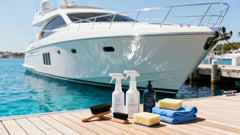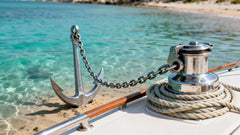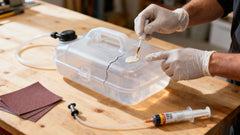How to Clean Pontoons for a Lasting Shine
When it comes to cleaning your pontoons, I’ve found it’s best to stick to a simple, four-part game plan: prep, clean, rinse, and protect. Following this process ensures you get rid of all that stubborn grime and oxidation without accidentally damaging the aluminum surfaces, bringing back that original shine we all love.
Your Essential Pontoon Cleaning Playbook
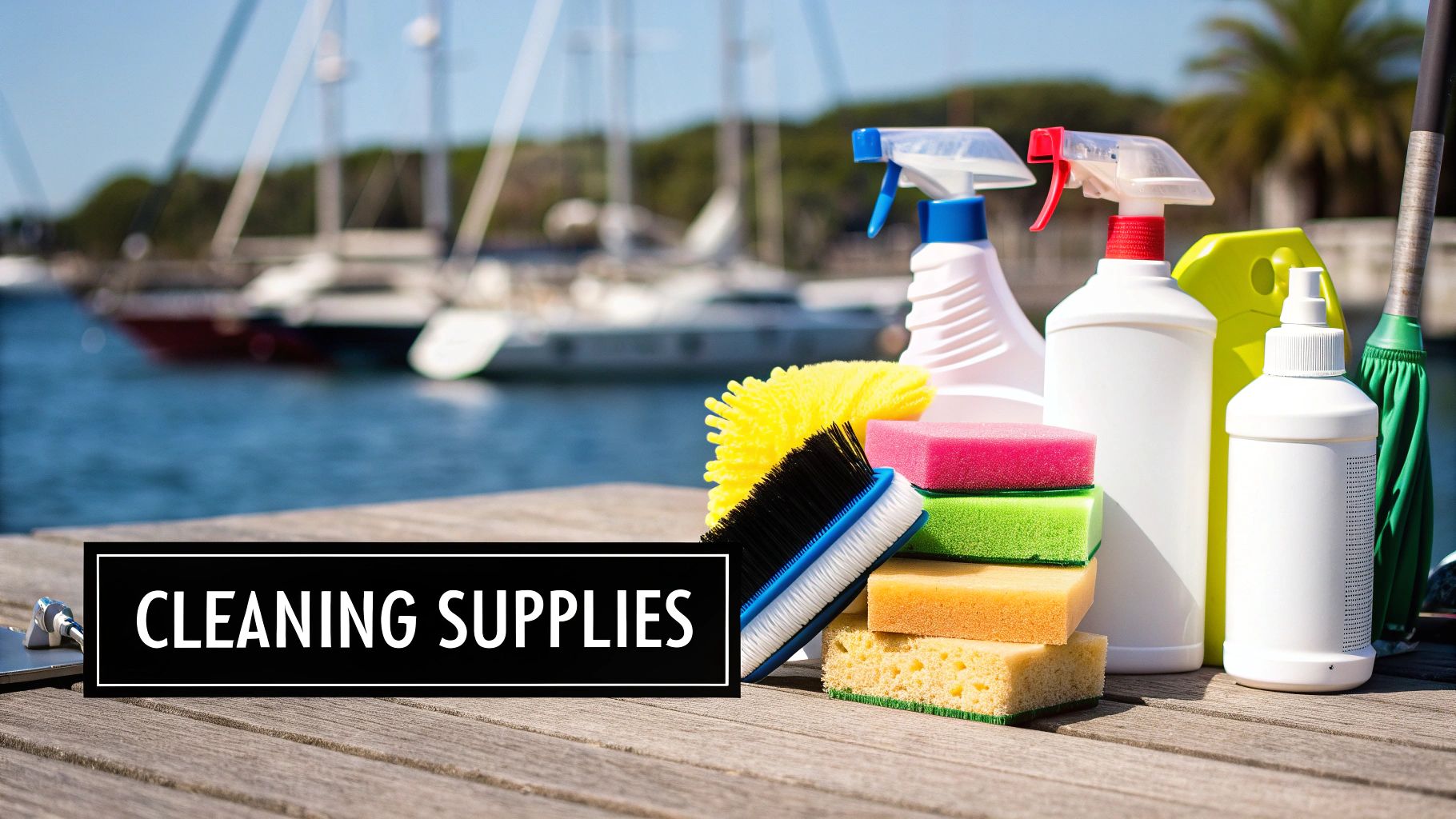
Before you even think about grabbing the hose, let’s map out the entire project. Think of this as your guide from start to finish. A great cleaning job always starts with great preparation, and from my experience, that means getting all your supplies lined up and ready to go before you start.
Gathering Your Supplies
There's nothing worse than getting halfway through a job only to realize you’re missing a crucial tool. It completely kills your momentum. To keep that from happening, let’s run through a quick checklist of the essentials you'll need.
Having the right gear on hand can turn a tough, day-long chore into a much more manageable task. If you're building your arsenal from scratch, a comprehensive boat cleaning kit can be a great way to get everything you need in one go.
Here's a quick reference table to help you gather your gear.
Pontoon Cleaning Essentials Checklist
| Stage | Required Tools & Products |
|---|---|
| Prep & Safety | Waterproof gloves, safety glasses, drop cloth/tarp |
| Cleaning | Pressure washer (or a hose with a high-pressure nozzle), soft-bristle brush, buckets |
| Specialized Cleaners | High-quality Aluminum Cleaner (this is non-negotiable for oxidation) |
| Finishing & Protection | Marine-grade Metal Polish, protective wax or sealant, microfiber towels |
Having these items ready will make the entire process smoother and more efficient. Now, let's get to work.
Here's a pro tip from years of doing this: A simple rinse with fresh water after each trip can prevent up to 80% of surface damage from salt and grime buildup.
Seriously, this small habit makes a massive difference in maintaining both the look and the long-term integrity of your aluminum pontoons. For more great boat care advice, the experts at Discover Boating are a fantastic resource.
Setting the Stage for a Deep Clean
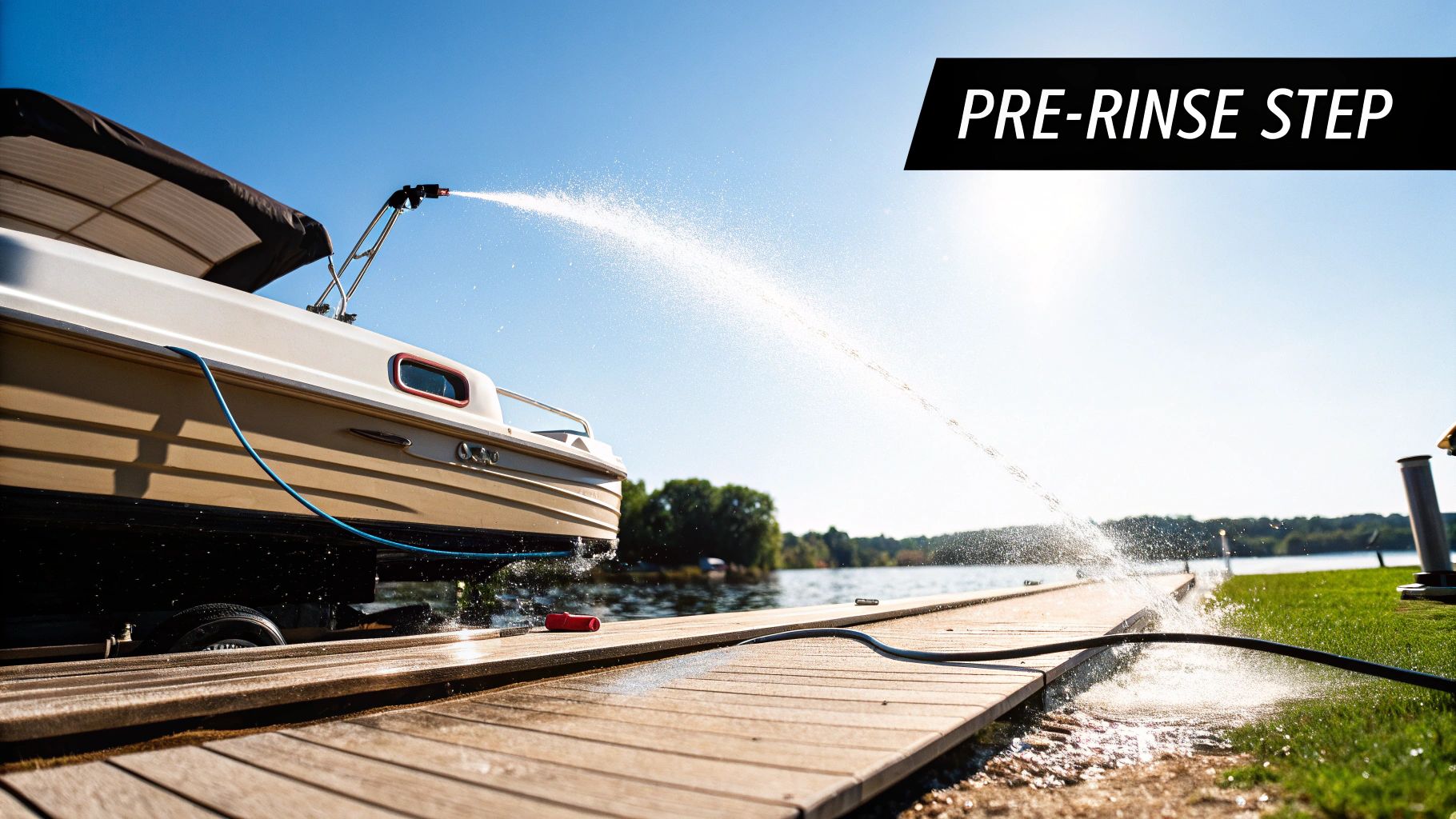
Any seasoned pontoon owner knows the secret to a less exhausting cleaning day isn't about scrubbing harder—it's about prepping smarter. Before you even think about popping the cap on a bottle of cleaner, your first move is getting that boat out of its natural habitat. Trust me, a proper deep clean just can't happen while it’s still floating.
You've got to get full, clear access to every inch of those aluminum tubes, especially that grimy waterline where all the nasty stuff loves to collect. The only way to really get at it is by getting your boat securely on a trailer or lift. This isn't just about making the job easier; it's a huge safety plus, giving you a stable platform to work from.
The Power of an Initial Rinse
Okay, so your boat is high and dry. I know the temptation is to jump right in with the scrub brushes and cleaners, but hold on. Grab your pressure washer or a garden hose with a good high-power nozzle first. This initial rinse is your best friend.
Your mission here is simple: blast away all the easy-to-remove gunk. Think of it as skimming the low-hanging fruit off the top. This gets rid of:
- Loose algae and lake scum that hasn’t yet baked on.
- The light layers of mud and dirt from your last few trips out.
- Any other surface-level grime that a good spray will wash right off.
Taking a few minutes for this pre-rinse will drastically cut down on the elbow grease you’ll need later. You’re letting the power of water do the initial heavy lifting, which saves your energy for the stubborn, set-in stains that need a more targeted approach.
Tackling years of buildup requires a powerful approach. To achieve a truly deep clean, utilizing effective pressure washing techniques can be invaluable for removing the toughest layers of grime before you apply any cleaners.
A thorough first rinse really sets the stage for success. It means your aluminum cleaners can get to work directly on the tough oxidation and stains, instead of wasting their power fighting through a layer of simple dirt. It’s a small step that pays off big time.
Removing Stubborn Stains and Oxidation
Now that the surface grime is gone, it’s time to face the real challenge: the stubborn, set-in stains and that chalky, dull film of oxidation. This is where a little know-how can take your boat from just clean to genuinely restored. Let's be honest, simple scrubbing isn't going to touch those deep waterline stains or that persistent green algae.
To really tackle these problems, you need the right tool for the job. We're talking about a high-quality aluminum cleaner or brightener. These aren't just soaps; they're formulated to chemically break down oxidation and lift marine stains without hurting the metal itself. When you spray on a product like our Aluminum Cleaner, you'll often see it start to foam up and get to work almost instantly on the oxidized spots.
Applying Aluminum Brightener Correctly
Using an aluminum brightener is pretty straightforward, but your technique really does matter. I've found it's best to work in small, manageable sections—think three to four feet at a time. This keeps the cleaner from drying on the surface before you can rinse it, which can leave you with streaks that are a pain to get rid of.
Give the cleaner about 5-10 minutes to sit. That's usually the sweet spot for it to penetrate the oxidation without drying out. You’ll actually see the chalky white haze start to dissolve, and that’s your signal to start scrubbing.
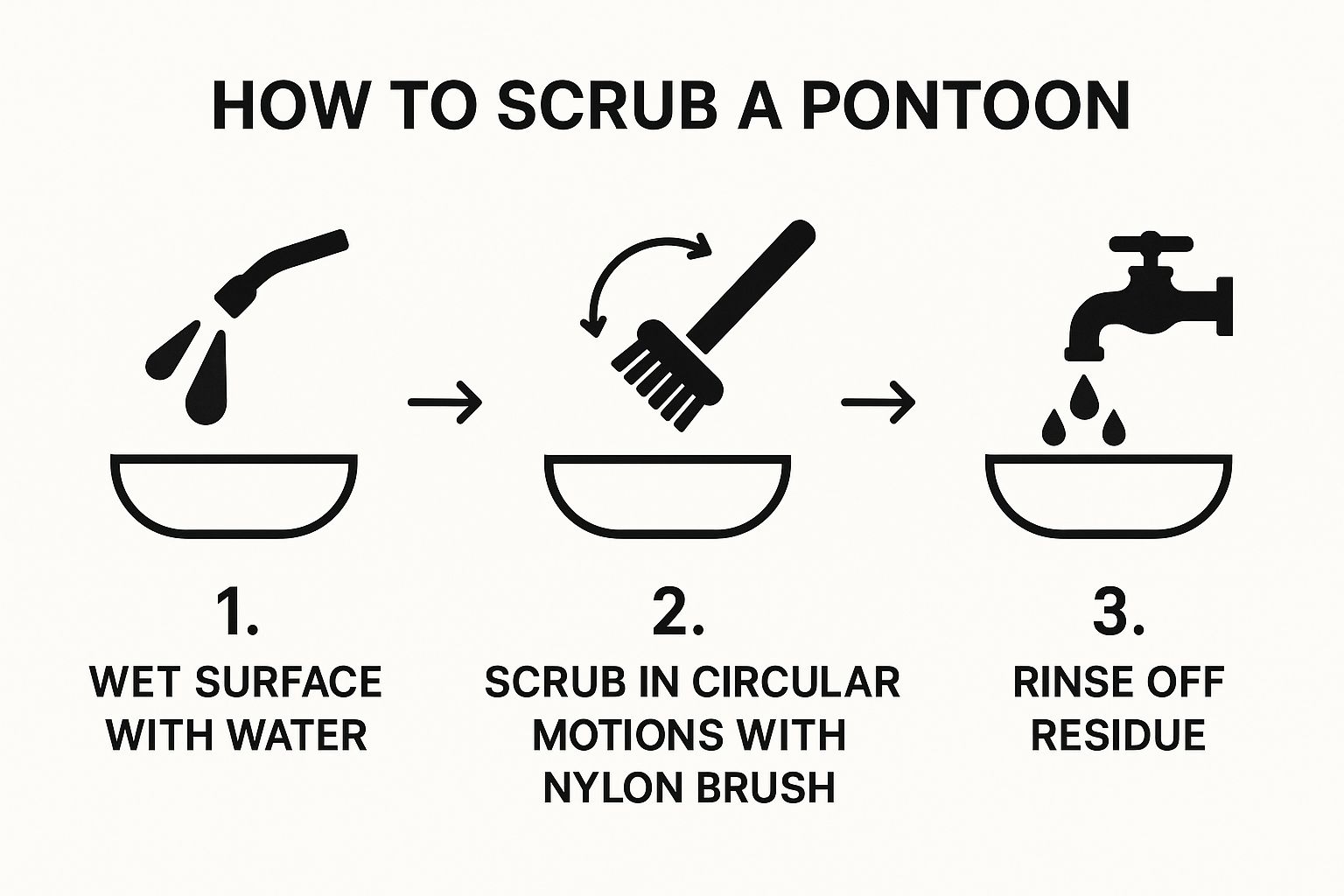
The key is to use a non-abrasive brush with consistent motions. You're just trying to lift the grime that the cleaner has already loosened, not scratch up the aluminum. Once you're done scrubbing a section, rinse it thoroughly.
A good rule of thumb is to let the chemical do the heavy lifting. You don't need to put a ton of muscle into it. A firm but gentle motion with a soft-bristle nylon brush is all it takes to agitate and lift away the dissolved grime.
It turns out we're not alone in being meticulous. In fact, 83% of boat owners clean their vessels before moving them over land, using everything from simple brushes to high-pressure sprays. It just goes to show how important a detailed cleaning routine is for preventing long-term damage and keeping your boat in great shape.
If you're dealing with some really caked-on buildup, it can be helpful to see how pros handle similar tough spots on other surfaces. This expert guide on how to clean pool tiles for stubborn stains is a great example. The core principles—using the right chemical and proper agitation—often apply across the board. After you’ve beaten the oxidation, check out our comprehensive guide on boat oxidation remover for even more in-depth strategies. With the right approach, even the most neglected pontoons can be brought back to a brilliant shine.
Protecting Your Pontoons and the Planet
A clean boat is a point of pride, but not at the expense of the very water we all love. Being a responsible boater is about more than just a shiny finish; it's about being mindful of the products we use and where the runoff ends up. It's a simple way to keep both your pontoon and the environment in great shape.
The first, and most important, move you can make is choosing the right cleaner. You want to look for formulas that are clearly labeled as biodegradable and marine-safe. These products are made to break down naturally without harming fish and other aquatic life, which is a big deal when you're working right at the water's edge. You don't need harsh chemicals to get a powerful clean.
Preventing Pollution and Invasive Species
Where you clean your boat matters just as much as what you clean it with. Whenever you can, pull your boat away from the shoreline before you start scrubbing. Even with eco-friendly products, the goal is to keep direct runoff out of the lake or river.
A simple pro tip is to find a grassy or gravel area to work on. These surfaces are great at absorbing and filtering the water. If you're stuck on pavement, a catch mat can contain the runoff so you can deal with it properly later.
This isn't just a friendly suggestion; it's becoming a standard for responsible boat maintenance. Experts often recommend using mild, non-acidic cleaners and always rinsing with fresh water to cut down on pollution. You can find more great, environmentally-friendly pontoon boat maintenance tips on Boattest.com.
Beyond the cleaning products, you're also the first line of defense against invasive species. Before you leave the ramp, always give your pontoons and trailer a good look-over for hitchhikers like zebra mussels or sneaky aquatic plants. These guys can cause serious damage when introduced to new waters.
A thorough cleaning and drying is usually all it takes to make sure you’re not giving them a free ride. It’s a small step that makes a massive difference in keeping our waterways healthy for everyone, for years to come.
Applying Polish for a Mirror Finish
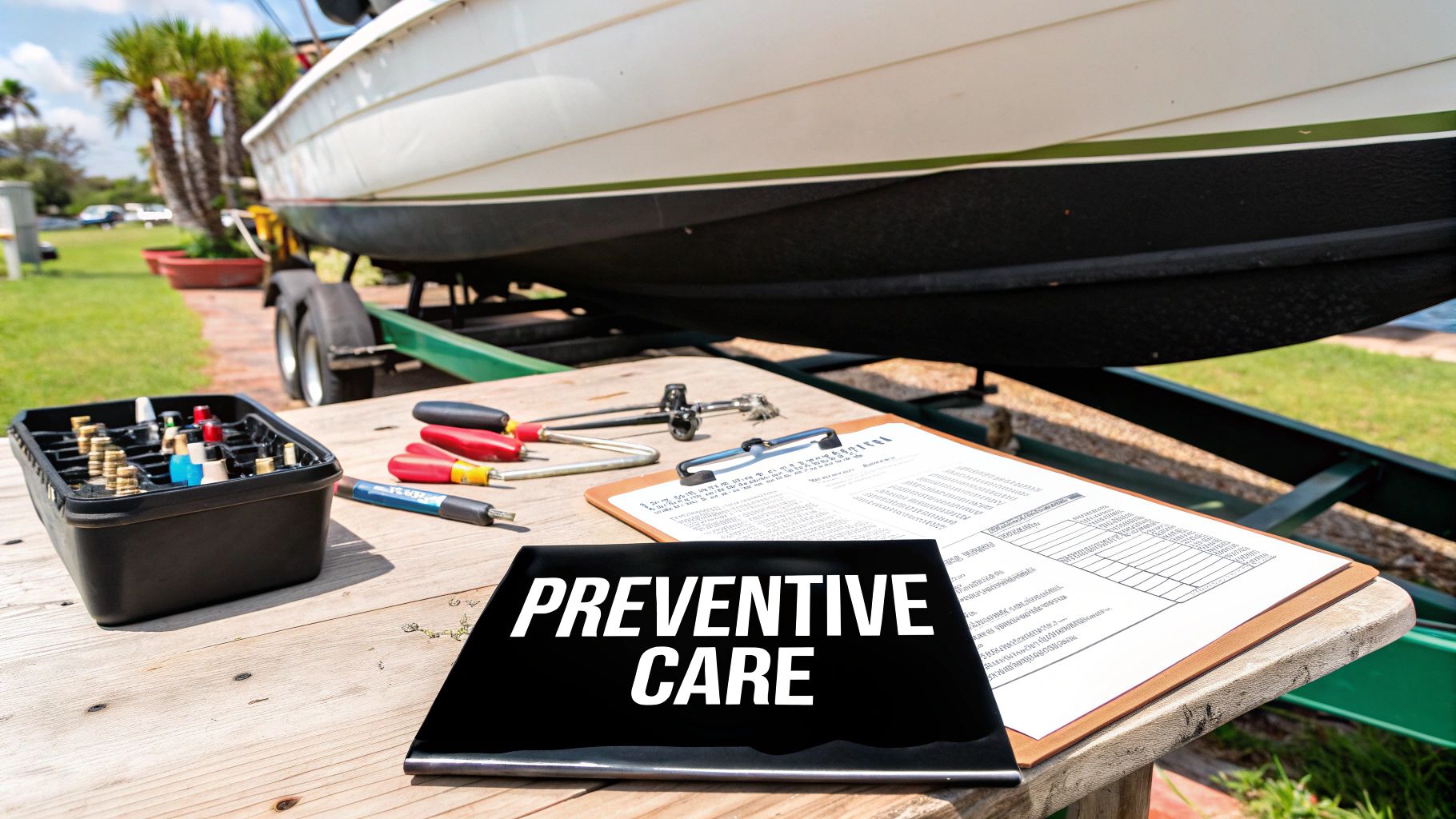
After all that scrubbing, your pontoons are finally clean. But don't pack it in just yet. This is the step that separates a decent cleaning job from a professional-grade finish that really turns heads at the dock.
This is where a quality aluminum polish comes in. It’s your ticket to restoring that brilliant, factory-fresh shine. You’re not just wiping it on; you’re working it into the metal to buff out any lingering dullness and create a smooth, highly reflective surface. Think of it as bringing the aluminum back to life.
Sealing in the Shine
Once your 'toons are gleaming, the next move is to lock that shine down. This is where a marine-grade wax or a modern polymer sealant earns its keep. Applying this protective layer does a lot more than just add a little extra gloss—it creates a tough barrier against the elements.
This barrier is your best defense against having to do this whole deep-clean process again anytime soon. It gets to work right away to:
- Repel water, which keeps those ugly mineral deposits and waterline stains from forming in the first place.
- Block UV rays that can dull out aluminum over time.
- Prevent oxidation, stopping that chalky, white buildup before it even gets a chance to start.
Think of this sealing step as creating an invisible shield for your pontoons. This coat dramatically slows down re-oxidation, meaning your boat stays gleaming for much, much longer. It also makes your next cleanup a whole lot easier.
Want to get that perfect, even finish with a lot less elbow grease? Using an electric power buffer is a total game-changer. It works the polish and sealant into the surface far more effectively than you can by hand, giving you a flawless, mirror-like result in a fraction of the time.
For a deeper dive into the nitty-gritty, our guide on how to polish pontoons to make them last covers some more advanced techniques.
Common Questions About Pontoon Cleaning
Even with a perfect game plan, you're bound to have a few questions. It happens to all of us. Let's run through some of the most common ones I hear from other pontoon owners. Getting these answers down can save you a ton of headache down the road.
Can I Use Household Cleaners on My Aluminum Pontoons?
I get this one a lot, and the answer is a hard no. It’s tempting to just grab something from under the kitchen sink, but trust me, it’s a terrible idea for your boat.
Most household products are packed with ammonia or other harsh chemicals that will absolutely wreck your aluminum. We're talking pitting, ugly streaks, and permanent damage over time. Always, always stick to cleaners made specifically for marine aluminum—it's the only way to protect your investment.
Marine-grade cleaners are engineered to tackle oxidation and that nasty lake scum without eating away at the metal's protective finish. The stuff you use in your house just isn't built for the job and will cause more harm than good.
How Often Should I Deep Clean My Pontoons?
For a full, out-of-the-water scrub down, you should aim for at least once a year. The end of the season is usually the perfect time to get all that summer's buildup off before storage.
Now, if you're boating in saltwater or a lake known for aggressive marine growth, a mid-season clean is a really smart move. It keeps stubborn stains from becoming a permanent fixture. And for day-to-day care? A quick freshwater rinse after each trip works wonders.
Is a Pressure Washer Safe for Pontoons?
It sure is! In fact, it's a massive time-saver for that first big rinse. You just have to be smart about it.
- Stick with a wide fan-spray nozzle. A 40-degree tip is great. Never use a pinpoint jet—it can concentrate too much force and actually etch the aluminum.
- Keep it moving. Don't hold the nozzle in one spot for too long. Maintain a safe distance and use smooth, sweeping motions.
- Watch out for the sensitive spots. Be extra careful around your decals, any wiring, and sealed components. A direct blast can peel them right off or force water where it shouldn't be.
Ready to see your pontoons shine like new? The complete line of Better Boat cleaning and polishing products is designed to give you that professional gleam with less elbow grease. Find the perfect solution for your pontoon today at https://www.betterboat.com.


